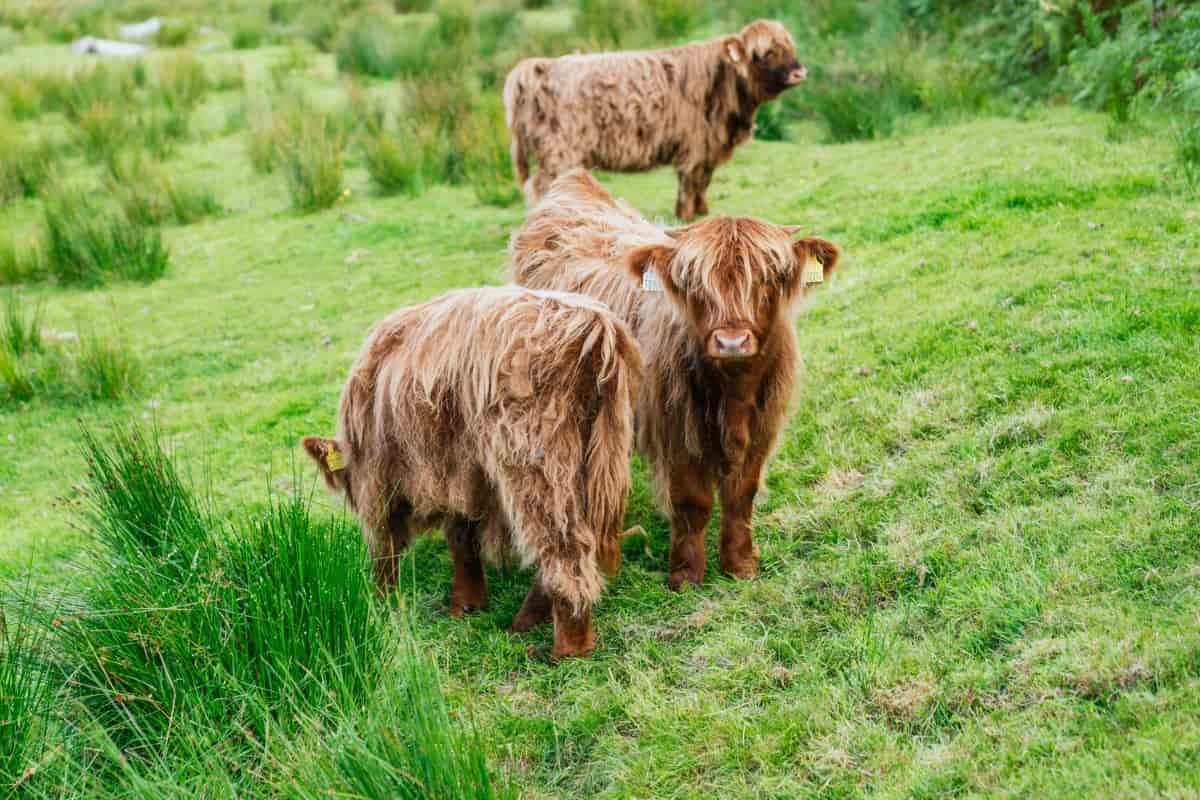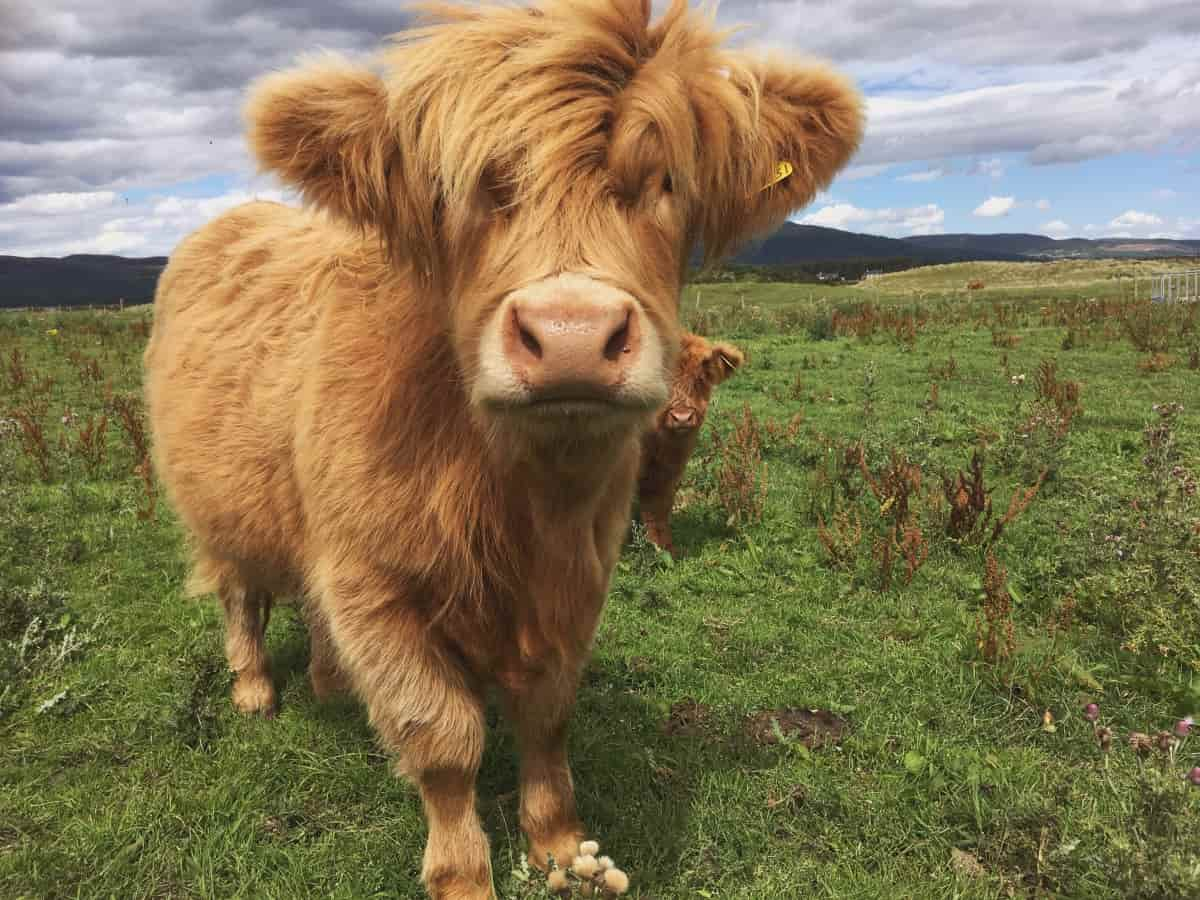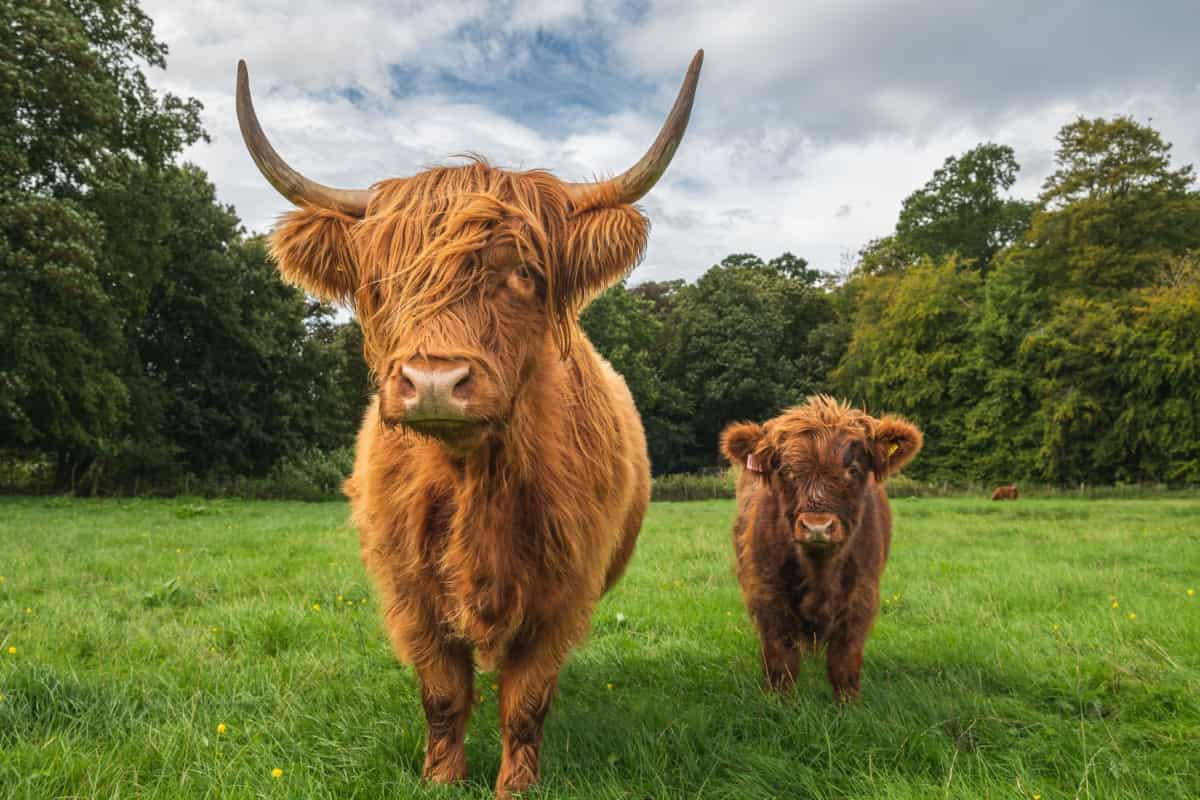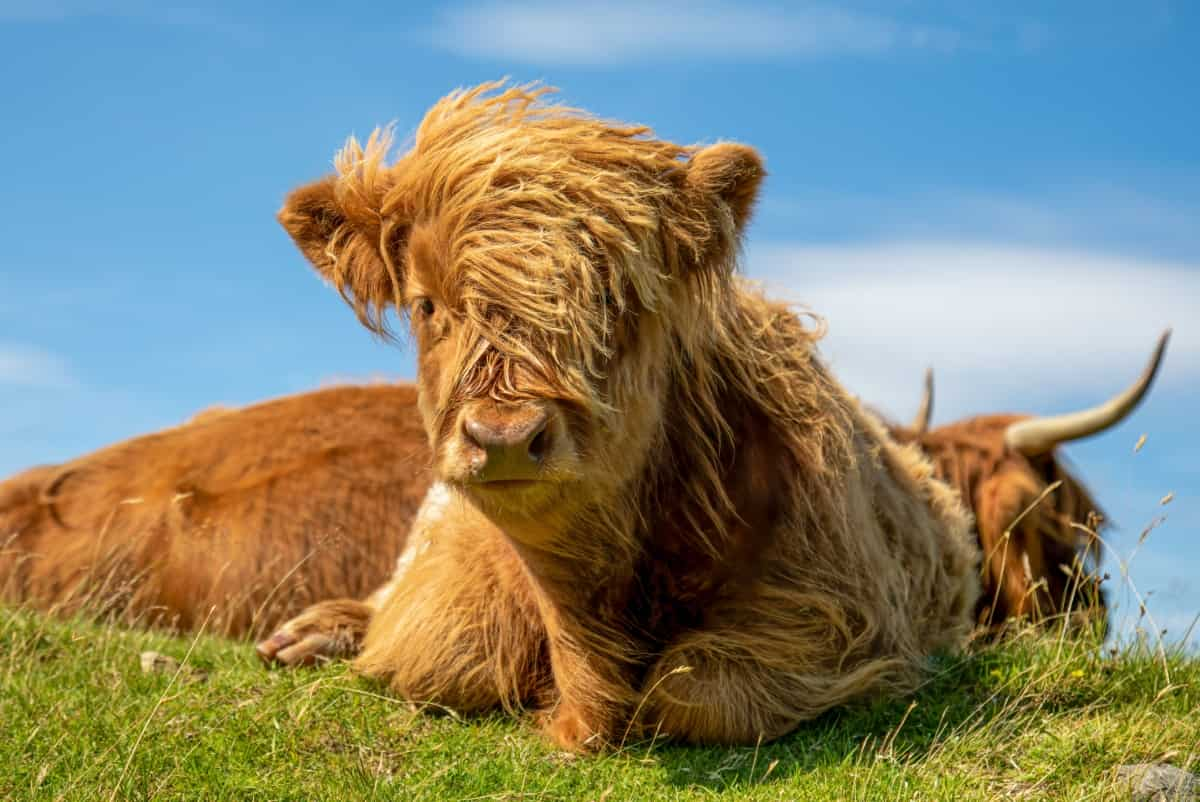Mini Highland Cattle, often affectionately referred to as “miniature Highlands” or “mini Highlands,” are a downsized version of the Scottish Highland Cattle breed. Renowned for their distinctive long, shaggy hair and impressive horns, Highland Cattle have been a fixture in the rugged landscapes of Scotland for centuries.

The miniature version of these iconic bovines offers all the charm and appeal of their larger counterparts in a more compact package. This article covers everything you might want to know about them, including mini highland cattle care and the economic benefits of highland cattle.
Mini Highland Cattle
Overview of Mini Highland Cattle
History and Origins: Originating from the Highlands and Islands of Scotland, Highland Cattle have existed for centuries, prized for their hardiness and adaptability to harsh climates. Miniature versions are selectively bred from standard Highland Cattle to maintain their distinctive characteristics in a smaller size.
Physical Characteristics and Traits: Mini Highland Cattle possess the iconic long, shaggy hair and majestic horns of Highland cattle, along with their characteristic double coat that provides insulation in harsh climates. They typically exhibit gentle temperaments and are well-adapted to rugged terrain.
Size and Weight: Mini Highland Cattle are significantly smaller in size compared to standard Highland cattle, with heights ranging from 36 to 42 inches at the shoulder and weights ranging from 500 to 700 pounds.
Lifespan: Mini Highland Cattle have a similar lifespan to standard Highland cattle, averaging around 15 to 20 years with proper care and management.
Price: The price of Mini Highland Cattle varies depending on factors such as lineage, conformation, and market demand, but they generally command a premium due to their unique appearance and adaptability. Prices can range from $3,500-$5,000 per animal.
Mini Highland Cattle Habitat and Living Environment
Ideal Living Conditions: Mini Highland Cattle thrive in environments with ample grazing pasture, access to fresh water, and shelter from extreme weather conditions. They do well in areas with rugged terrain where they can utilize their surefootedness to navigate hills and rocky landscapes.
Adapting to Various Climates: Given their hardy nature and adaptation to the harsh Scottish weather, Highland cows can thrive in various climates, even in conditions many other breeds might find challenging. Their thick double coats provide insulation against harsh weather, making them well-suited for temperate or even harsher climates.
Diet and Nutrition
Essential Nutrients for Mini Highlands
Mini Highland cattle require a balanced diet rich in protein, fiber, vitamins, and minerals to support their growth, reproduction, and overall health. Key nutrients in a mini highland cattle diet should include protein for muscle development, energy sources like carbohydrates, and minerals like calcium and phosphorus for bone health.
Feeding Schedule and Diet Plans
Mini Highlands should be fed based on their age, weight, and activity level. A typical feeding schedule includes two meals per day, with access to fresh water at all times. Their diet should be high-quality forage, such as grass or hay, supplemented with grains or commercial feed to meet their nutritional requirements. A rough estimate of feed per day is around 2-3% of their body weight, with adjustments made based on individual needs and seasonal variations in forage quality.
Health and Wellness
Common Health Issues and Prevention
Mini Highland Cattle are generally hardy; however can be susceptible to common cattle health issues such as parasites, respiratory infections, and foot problems. Prevention involves regular monitoring, proper nutrition, and maintaining clean living conditions. Regular deworming, vaccination, and providing adequate shelter can help mitigate these risks.
Routine Veterinary Care and Vaccinations
Regularly provide veterinary care to maintain optimal highland cattle health management. This includes annual check-ups, deworming, and vaccinations against diseases like clostridial infections, bovine respiratory disease, and leptospirosis. Also, maintaining proper nutrition and addressing any health concerns promptly is crucial for their well-being and productivity. Consulting with a veterinarian to develop a customized health management plan is recommended.
In case you missed it: Dexter Cattle Farming: Exploring from Breeding to Marketing Strategies

Breeding and Genetics
Understanding Breeding Practices
Mini highland breeding practices involve selecting for traits like size, temperament, and conformation while ensuring genetic diversity. Breeders often utilize artificial insemination and selective breeding to achieve desired characteristics.
Genetic Traits and Heredity
Mini Highland Cattle inherit traits such as coat color, horn shape, and size from their parents through Mendelian inheritance patterns. Breeding programs focus on preserving these traits while minimizing health issues commonly associated with dwarfism or small stature.
Highland Cattle Temperament and Behavior
Social Behavior and Group Dynamics
Mini Highland Cattle typically exhibit docile and gentle temperaments, making them suitable for small farms or hobby farming ventures. They are known for their curious and friendly demeanor, often forming strong bonds with their caretakers. Mini Highland Cattle thrive in social settings and enjoy the company of their herd members. They establish hierarchies within the group but generally maintain peaceful interactions.
Handling and Interaction Tips
When handling Mini Highland Cattle, it’s crucial to approach them calmly and confidently, avoiding sudden movements that may startle them. Establishing trust through gentle interactions and consistent handling helps in building a positive relationship. Additionally, providing regular access to quality forage and comfortable shelter contributes to their overall well-being and cooperative behavior.
Grooming and Daily Care
Coat and Hoof Maintenance
Regular brushing helps keep the Mini Highland’s thick coat free of tangles and debris. Hoof trimming should be performed every 6-8 weeks to prevent overgrowth and foot problems. Check for signs of lameness or discomfort regularly.
Seasonal Grooming Needs
During the shedding season, increase brushing frequency to remove loose hair and prevent matting. In hot weather, provide shade and access to water to prevent heat stress. In colder months, ensure shelter from harsh weather elements and consider supplemental feeding to maintain body condition. Regularly grooming mini highland cattle and check for signs of parasites and treat as necessary.
Training and Handling
Basic Training Techniques
Mini Highland Cattle can be trained using positive reinforcement methods. For mini highland cattle training, start with basic commands like “come” and “stay,” rewarding desired behavior with treats or praise. Keep training sessions short and consistent, focusing on building trust and communication.
Safety Measures and Handling Tips
When handling Mini Highland Cattle, maintain a calm demeanor to avoid spooking them. Use secure enclosures with sturdy fencing to prevent escapes. Approach from the side rather than directly head-on to reduce stress. Always be mindful of their horns and maintain proper distance to ensure safety for both you and the animal.
In case you missed it: Cattle Fattening Business Plan: License, Cost to Start, and Profits

Economic Aspects
Cost of Rearing and Maintenance
Rearing and maintenance costs for Mini Highland Cattle include expenses for feed, shelter, healthcare, and occasional grooming. However, these costs are usually lower compared to larger cattle breeds due to their smaller size and efficient foraging abilities.
Potential Revenue Streams
Potential revenue streams from Mini Highland Cattle include selling breeding stock, meat, hides, and other by-products. Additionally, offering agritourism experiences, such as farm tours or educational workshops, can generate supplemental income for owners. Their unique appearance and desirable traits can also attract premium prices in niche markets, enhancing revenue potential.
In case you missed it: How to Prepare Cattle Feed at Home: DIY Procedure

Conclusion
In summary, Mini Highland Cattle offers unique opportunities for small-scale farmers and homesteaders interested in raising a distinctive breed known for its hardiness, temperament, and high-quality beef. However, careful consideration of the economic aspects, including initial investment, maintenance costs, income streams, market demand, and potential challenges, is vital for a successful venture in Mini Highland cattle farming.
- Feed Your Flock for Less: Top 10 Tips to Save on Chicken Feed
- Ultimate Guide to Ossabaw Island Hog: Breeding, Raising, Diet, and Care
- Hatching Answers: The Top 10 Reasons Your Chickens Aren’t Laying Eggs
- Eggs and Economics: Breaking Down the Cost of Raising Backyard Chickens
- Defend Your Greens: Proven Methods to Keep Iguanas Out of Your Garden
- Ultimate Guide to Cinnamon Queen Chicken: A Comprehensive Guide for Beginners
- Ultimate Guide to California Tan Chicken: Breeding, Raising, Diet, Egg-Production and Care
- Ultimate Guide to Marsh Daisy Chicken: Breeding, Raising, Diet, and Care
- 10 Types of Chicken Farming Businesses You Can Start for Profits